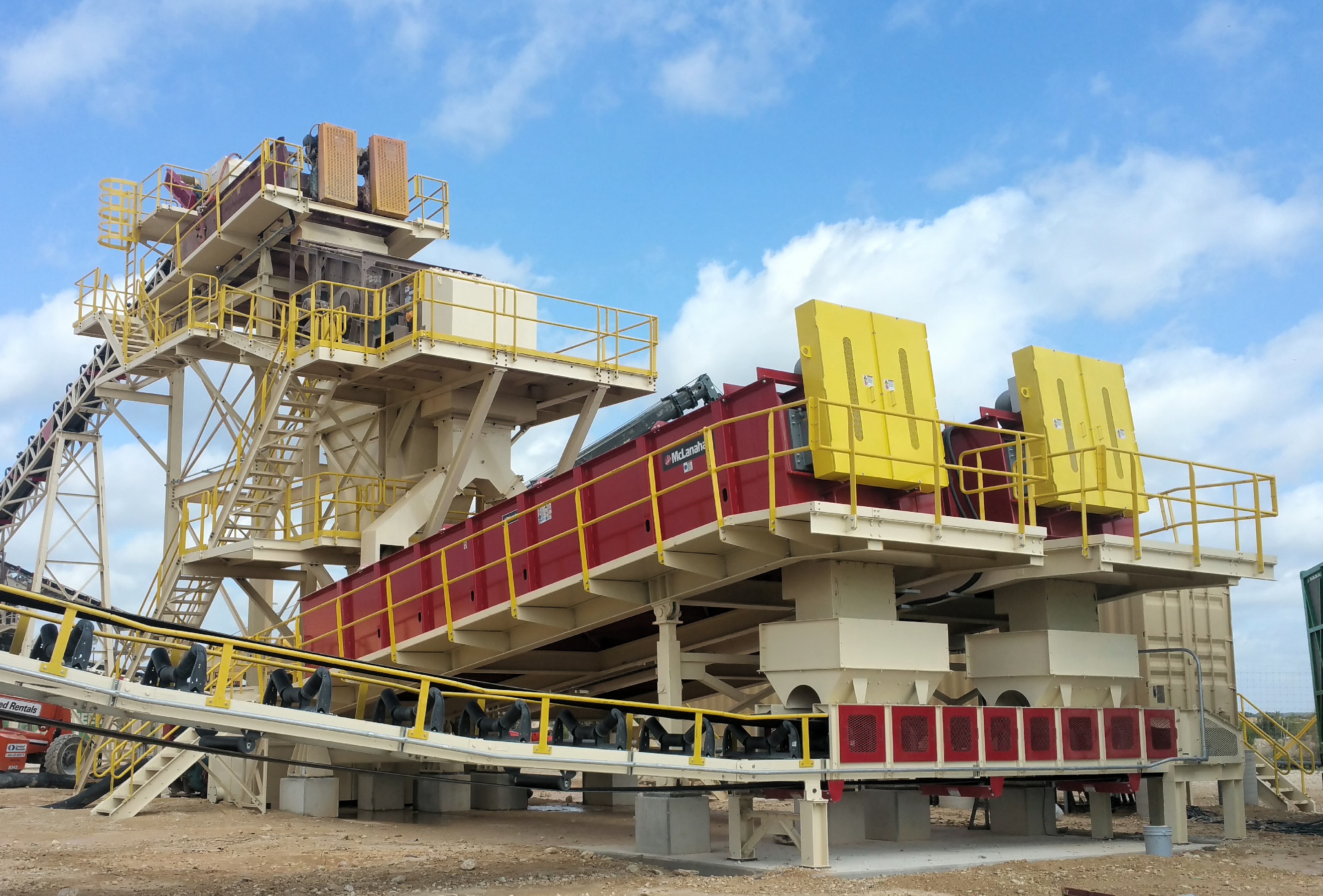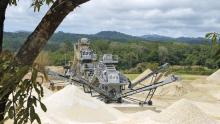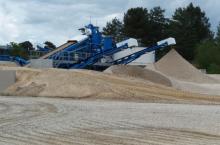
Major proven plant installations and new product launches are making for a vibrant global washing solutions market. Guy Woodford reports.
After doubling its sand production in 2017 following the installation of a
Located in Gauting, 10 miles south of Munich, Germany, sand and aggregates producer Kies- und Quetschwerk Oberbrunn (KQO) has ordered a CDE high-tech attrition and scrubbing solution as well as an advanced Infinity screen to maximise the performance of its existing wet processing operations.
Prior to switching to an initial CDE EvoWash wet processing plant in 2017, KQO was using a bucket wheel and fines recovery cyclone. However, the company was dealing with issues that prevented it from getting the most out of its raw material. These included the need for continuous maintenance as well as the installation’s limited capacity, which restricted production to a maximum of 35tonnes of sand/hour if the quality and consistency of the final sand product were to be ensured. The company decided it was time to upgrade its operation in order to double its sand production, which would then be delivered in its totality to a concrete batching plant located next to a new sand washing plant.
KQO’s managing director, Manfred Kirschler, said: “When we initially met with Christoph Aubel from CDE back in 2016, we were ready for a radical upgrade of our operations. We were aware that we were not exploiting fully our reserves of limestone and we wanted a plant that was able to process a lot more sand than the existing 40,000 tonnes per year.
“Mr Aubel had identified a requirement for a wet processing plant that would be easy to adapt to the layout of the company’s existing plant, and that would be efficient, reliable and economical. Our production has since doubled to 68,000 tonnes of sand per year.”
Christoph Aubel, of CDE’s large turnkey mineral processing projects division, ProMan, explains: “To adapt to the constraints of the site’s geography, the modular concept as well as the tailor-made design of each piece of equipment produced by CDE meant that an ideal solution for the client could be found without having to make compromises.”
So delighted has the company been with the performance of its CDE plant that a year after its EvoWash was installed, it has now decided to complete the upgrade of its installation by replacing its existing logwasher and screen with the new high-tech CDE AggMax logwasher, an Infinity screen and conveyors.
KQO’s decision to continue to invest in CDE technology comes from a number of issues related to the other on-site equipment. Kirschler said: “Our existing log washer and screens have been operating for 40 years now and both sit above the materials silos, which impacts negatively not only on the performance of the old equipment as well as maintenance costs, but also and crucially on the health and safety of our employees. We needed to create better access to the plant with an outside location.
“Our limestone-based raw material comes from an existing sand and gravel pit beside the plant and it was essential for us to be prepared for the possibility that the quality of the feed material may decrease in the future. Upgrading our wet processing plant now to immediately ensure better results made sense.
“Considering the excellent return on investment from our CDE EvoWash, we naturally turned to CDE, and Mr Aubel, again for advice on combining the best systems of attrition and scrubbing, wet processing and screening for optimal production quality and quantity.
“The EvoWash system has convinced us that the modular approach is best adapted to our site’s requirements in terms of footprint and other specificities.”
CDE and KQO agreed that the new equipment would join the EvoWash outdoors for ease of access and be modular to fit the layout of the site. A heavy-duty CDE AggMax 253 to manage even the most difficult material, a weld-free inclined double deck Infinity screen and three 15-metre conveyors were chosen as the best modular solution to replace the old equipment with advanced solutions that would perfectly complete the EvoWash.
Launched at bauma 2016, CDE’s Infinity technology which adapts to dry and wet applications has proved a huge success across the world. Built to last, Infinity screens feature a weld-free design and generate the same acceleration as conventional screens with less weight, which results in a reduction in power consumption, reducing operational costs. Aubel adds: “Another key focus in the development of the Infinity screen range was to ensure that essential plant maintenance could be carried out safely, quickly and easily and there are several examples of this to highlight.
“The most obvious is probably the distance between the screen decks of 750mm. This allows operators easy access between the screen decks for replacement of screen media and also ensures that this can be completed in as short a time as possible. This will be of essential value to the new Kies- und Quetschwerk Oberbrunn installation.”
Hard wearing and conceived for ease of maintenance, the new AggMax 253 is said by CDE to take care of even the most difficult material to ensure that the quality and quantity of the production remain consistent. A modular scrubbing and classification system featuring an innovative paddle design, the CDE logwasher maximises product yield from clay-bound feedstock.
The new comprehensive CDE solution, which will be commissioned later this year, has been designed to accept 200tonnes/hour of limestone feed to produce 0-4mm (30% of the production), 4-8mm, 8-16mm and 16-32mm (50% of the production) and 32/X which will be crushed (20% of the production). The entirety of the processed material will be delivered to the Heidelberg Cement batching plant located right beside the customer’s site. The expected tonnage/year is over 200,000tonnes.
A new quarry in West Deeping, Lincolnshire, central England, has just started supplying high quality sand and gravel to
Replacing the exhausted Manor Pit operation nearby, the new West Deeping site has reserves which will secure the site for several years and features a new
West Deeping is now one of three large processing operations within the CEMEX UK central area, with the others being Rugeley and Swinderby.
Philip McComb, quarry manager at West Deeping, said: “We have been very lucky that we started with a blank piece of paper and benefited from previous experience with other plant supplied from various manufacturers, so we are very fortunate that we have a plant that has been through a design process and eliminated issues we have experienced in the past. Working with the CEMEX engineering department we arrived at what was required on-site and after various consultation and site visits DUO designed us a plant based on the TWS Fines Master FM200C which was accepted, and they were subsequently awarded the order.”
Capable of operating at up to 220tonnes/hour, the plant consists of a bespoke feed system which is fed by wheeled loader, via a feed hopper which incorporates a remote-control tipping grid. Material is then fed up the inclined feed conveyor onto the 20x6 three-deck rinsing screen which utilises individually controlled spray bars on each deck which are fitted with polyurethane modular media.
Acting as a protection deck the top deck removes any rejects up to +90mm and clay to stockpile and any oversize +40mm is sent to a further stockpile with the bottom deck providing the feed to the Fines Master 200C to produce the required sands.
A static sand recovery unit on one chassis, the FM 200C features a centrifugal slurry pump, a 14x6 dewatering screen and twin hydro cyclones that produce two in-specification sands
A specially designed rubber-lined underflow box allows blending to take place so that an acceptable coarse and fine sand ratio can be achieved. These sands are then delivered to separate radial conveyors and stockpiled.
McComb said: “Originally the radial arc was going to be two equal runs, but as we produce more sharp sand naturally we decided to install a split arc with most of the arc utilised by the sharp sand conveyor to allow us a larger stockpile.”
Any remaining gravels off the first screen are then fed onto a second inclined transfer conveyor which feeds onto a 3-deck part rinser which takes out and provides feed to 6/10/14 and 20mm stockpiles.
McComb continued: “This second split also features the option of redirecting the feed to the -6mm conveyor only, through a set of flaps. This is an event we schedule every couple of weeks to produce a 4/20mm for our concrete plants. This is, along with sharp sand, our main seller; although currently 4/10mm is in demand and as our material is very clean the 2/6 and 4/10mm also have added value as they can be potentially sold as decorative gravel.”
McCloskey Washing Systems (MWS) launched its Compact Sand Plant (CSP) at the AGG1 and World of Asphalt Show in Houston, Texas, USA.
The new additions to the MWS product range are compact sand plants CSP 60, CSP 120, CSP 200 and CSP 250 single and twin sand plants. The range has been designed to give the ultimate choice and flexibility to meet customers’ expectations.
Commenting on the decision to unveil the product line at the National Stone, Sand and Gravel Association’s (NSSGA’s) flagship 6-8 March 2018 event, Sean Loughran,
The McCloskey Compact Sand Plant range enables superior separation efficiency, produces the driest, drip-free final washed sand product, and produces up to two in-spec sands, to the desired grade, at up to 250tonnes/hour.
As with all McCloskey products, these plant are said to have been designed with the machine operator in mind. In addition to the highest level of quality and performance, significant benefits are said to include simple and fast assembly times, ease of operation, low maintenance and an overall reduced footprint.
The McCloskey S130 and S190 Tracked Rinsers, paired with the right size Compact Sand Plant (CPS), offer a portable wash plant option for up to 250tonnes/hour total sand production and an overall production of sand and aggregates of over 400tonnes/hour. By simply building up an elevated terrace on site to elevate the S130 or S190 Rinser nominally 7-8ft above the ground grade level that the CSP sits on, the tracked wet screen has plenty of elevation for gravity flow to move sand and water to the sump of the CSP.
Each CSP is individually tailored to suit any application, regardless of desired tonnage, from 20tonnes/hour - 250tonnes/hour, or silt percentage in the feed material.
McLanahan Mudmaster and Super Mudmaster log washers can accept feed material up to 150mm cubed. As the percentage of material to be removed increases, longer units should be used to increase the washing action. In very severe applications, two or more log washers may be required.
After deleterious material has been liberated, clean material moves upward between the shafts and discharges out the bottom of the box after a final rinse. Deleterious materials are absorbed into the water and carried over a weir on either side of the box. In high capacity applications, an optional rising current system helps lift waste fractions to the top of the water level and over the weir.
McLanahan’s fine material screw washers are primarily used to dewater, classify and wash sand or fine materials and can accept feed slurry from sand classifying tanks, hydrocyclones, hydrosizers and other fine material screw washers. This piece is especially useful if an application requires more retention time to hydrate materials.
Sand or other fine materials are directed to a baffle plate in the feed box. Coarser, heavier material sinks to the bottom of the box, while finer waste particles are carried to the surface by the up-current of the water and then over the weirs. Material that has sunk to the bottom is conveyed from the pool area up the 18-degree slope to the discharge end of the machine. As it moves further up the slope, it enters the dry deck area where the water begins to separate from the material.
Built primarily to wash crushed stone and gravel, McLanahan’s coarse material screw washers effectively remove light, loamy clays, dirt, crusher dust and coatings that cannot be removed by wet screening alone. They can also be used to take floating vegetation and soft aggregates out of the material feed.
Coarse material screw washer paddles are used in conjunction with screw flights to provide scrubbing, scouring and agitation. The turbulent washing action combined with rising current water, which is introduced at the feed-end at the bottom of the box, results in separation of the lighter fraction from the sound aggregates. Lighter fractions float to the surface due to water rising in the box and then overflow the weir located at the back of the box. Desired clean product is then scrubbed and conveyed by the paddles and flights to the discharge end of the box.
McLanahan’s sand manager classifying tanks provide a simple way to remove excess water, slimes and undesirable grain sizes from natural or crushed sand feeds. Meant to be used with a fine material screw washer or dewatering screen, these sand tanks are typically used to classify material by removing certain intermediate mesh sizes or to make multiple products from a single feed material. McLanahan also offers classifiers, hydrocyclones, separators, hydrosizers and more to help wash and classify a variety of aggregates products.
The plant handles many stages of production: washing and screening; gravel washing; sand recovery; water clarification; and sludge treatment – dehydration. It features washing drums and cyclones for sand recovery, the BaiWash system which includes thickeners able to offer efficient primary stage water treatment, and a CentriPod mechanical centrifuging system.
The BaiWash system for the customer in question has two steel tanks, each fitted with a long screw placed at the bottom that extracts the concentrated sludge and sends it for sludge dehydration. This is said to be an efficient method of generating high quality sludge while avoiding any clogging.
The BaiWash system is easily managed via its computer software. Through it you can control the flocculants dosing device, the evacuation of solids and all other services. BaiWash can also be remotely controlled via internet or LAN network. The complete system is also easier to move, as its modular-bolted sections ensure reduced installation time when the tank has to be moved from site.
The final stage in reducing the volume of water is dewatering the slurry by means of decanting centrifuge. While the water used for the washing is totally reused, thickened sludge is extracted from the bottom discharge of the tanks and is sent to the centrifuging step. To limit the cost of disposal of thickened sludge or limit the amount of material to bring to landfill, it is necessary to separate the excess of water in the same sludge, making the latter drier. The mechanical centrifuging method developed by Baioni – the CentriPod system - uses a decanter centrifuge.
Designed to require minimal maintenance, the CentriPod system is housed within two standard size 6.1 metre ISO containers in a stacked arrangement and can be shipped on any commercial truck. Monte Porzio, Marche, Italy-headquartered Baioni has delivered three units over the last two years to Barhale, a UK infrastructure services company.
The CentriPod system is pre-assembled in its own fabricated cradle and can be located to suit application. The system’s pump is a well-known industry standard Warman centrifugal type. A new PLC (programmable logic controller) designed by Baioni for the CentriPod includes a 38cm touch-screen control with full graphic display, allowing complete visual control of centrifuge speed, flow of feed and polymer pump, with a new closed loop control enabling a continuous feed of the polymer from zero to 2.000litres/hour. The PLC comes with a web cam connection to inspect different areas of the CentriPod, allowing users to act on any problems at the earliest opportunity.








